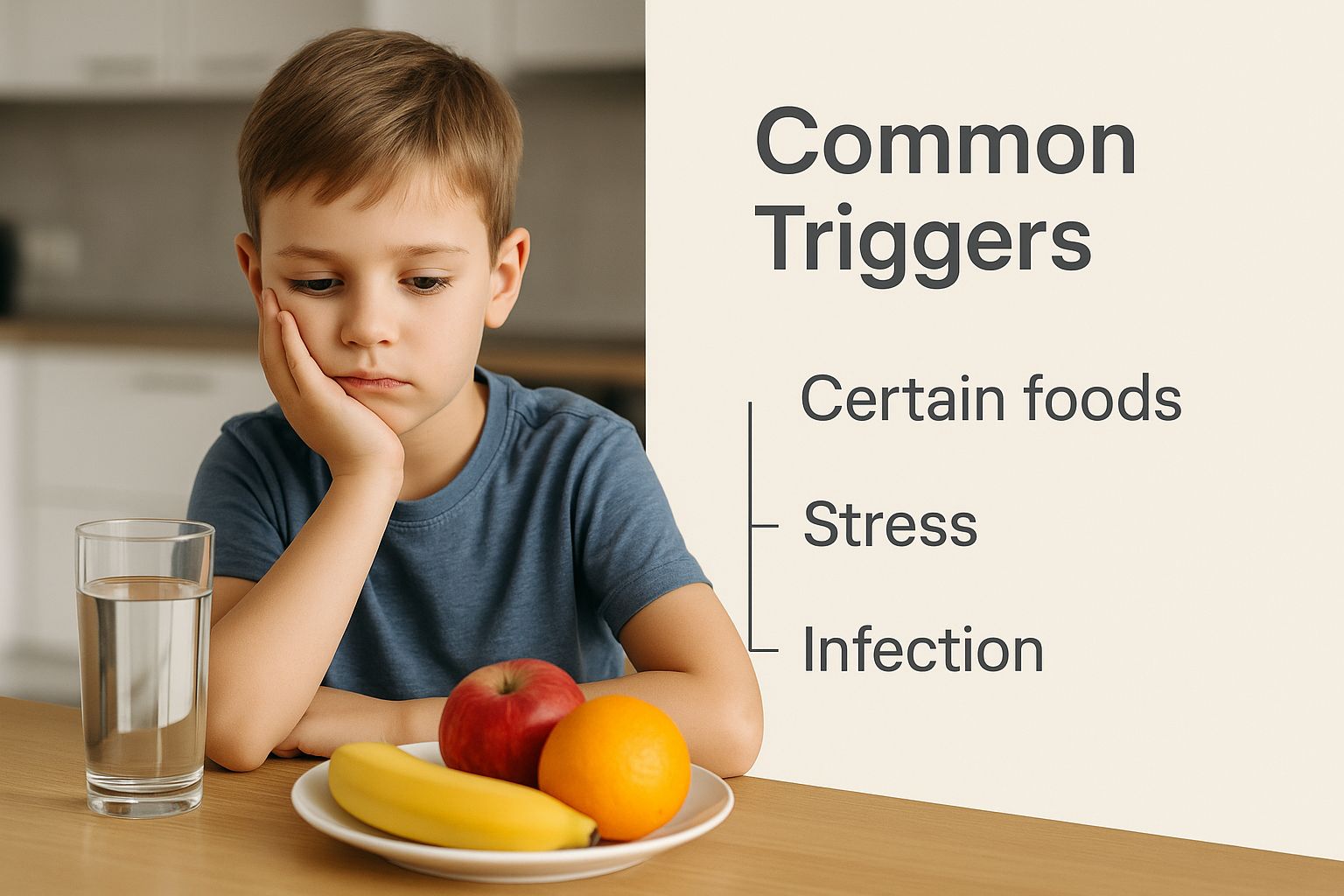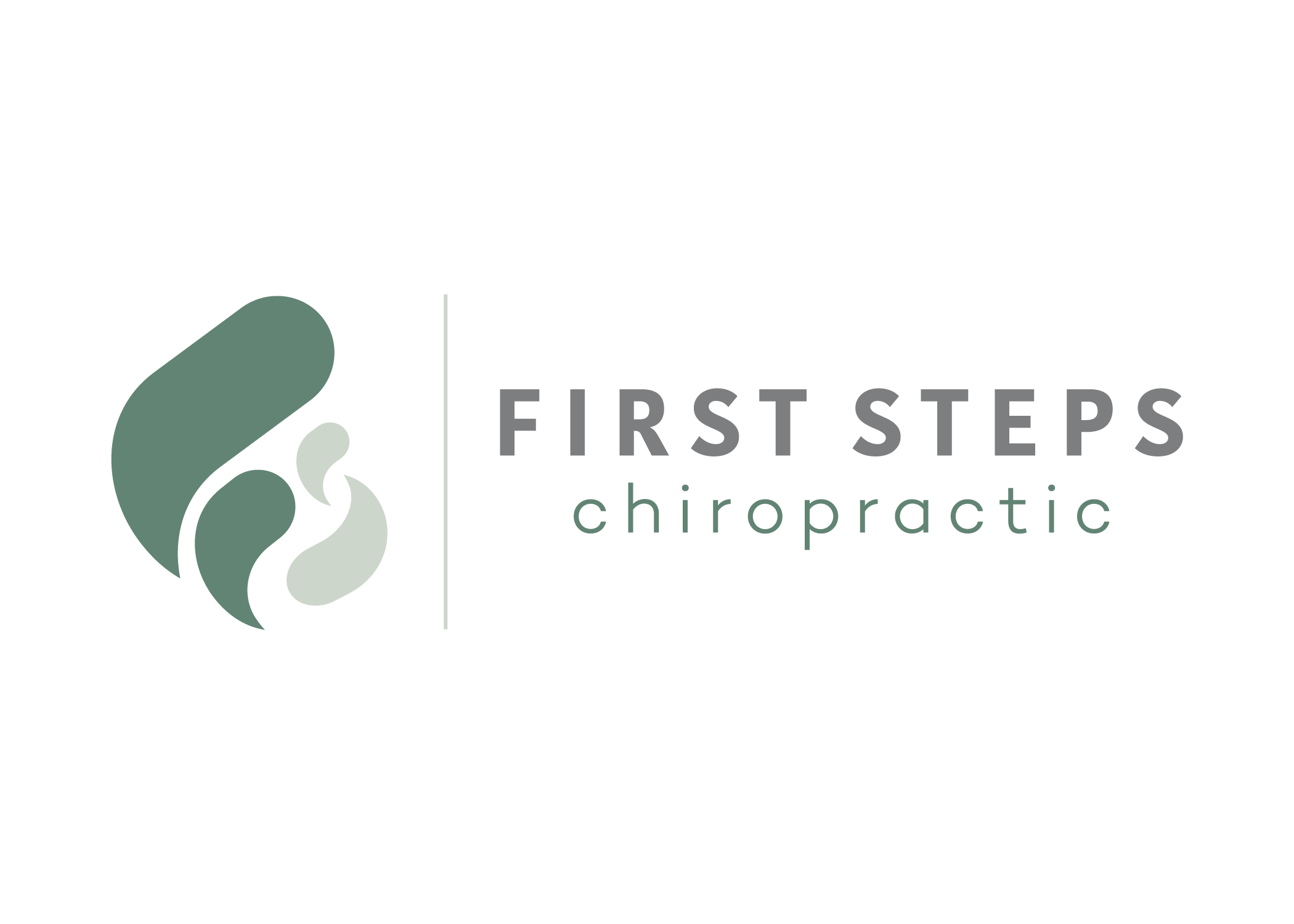When your child cries out with a throbbing head, it's completely natural to wonder, "What on earth is causing this?" The short answer is that a pediatric migraine isn't just a bad headache—it's a complex neurological event. It's often driven by a combination of genetic predisposition and specific environmental triggers, creating a sensitive brain that overreacts to certain things.
Decoding Your Child's Migraine
Watching your child suffer from a migraine is one of the hardest things for a parent to go through. You feel helpless. But it's so important to understand that this is a real, physiological condition, not something they can just "get over."
A migraine is like having an overly sensitive car alarm. For some kids, their brain's internal alarm system is simply wired to be extra sensitive. This sensitivity is often inherited; if migraines run in the family, there’s a much higher chance a child will experience them, too. Think of genetics as the factory setting for this high-strung alarm system.
But the factory setting alone doesn't set off the alarm. That's where triggers come into play.
Triggers are the everyday events, foods, or environmental factors that can flip the switch and start a migraine attack. For a child, these can be surprisingly common and often hard to spot.
A migraine is so much more than a headache—it's a neurological storm that can be completely disabling. The headache itself is just one of many potential symptoms, which can also include nausea, dizziness, extreme fatigue, and a painful sensitivity to light and sound.
The Real-World Impact
Understanding what causes migraines in children is the first step toward actually managing them. This isn't a minor issue; it's a significant health challenge across the globe.
In fact, migraines affect roughly 3% of children by age seven and a staggering 10% by age fifteen. While it's just as common in boys and girls before puberty, the numbers become two to three times higher in girls afterward. You can read more about how migraines impact children at the Children's Medical Association website.
These episodes can disrupt every single part of a child's world:
- School Performance: Frequent migraines can lead to missed school days, trouble concentrating in class, and falling behind on homework.
- Social Life: A child might have to constantly cancel plans, miss out on birthday parties, or skip sports practices, which can lead to feelings of isolation and deep frustration.
- Emotional Well-being: Dealing with unpredictable pain creates a ton of anxiety and stress, as kids start to worry about when the next attack will strike.
Once you start to demystify this condition, you can shift from a place of worry to one of empowerment. You'll be ready to spot the patterns and find solutions that actually work for your child.
Common Migraine Triggers in Children at a Glance
Spotting your child's specific triggers is like being a detective. It takes time and careful observation, but it's one of the most powerful things you can do to reduce migraine frequency.
This table gives you a quick summary of the most frequently reported triggers for pediatric migraines. Use it as a starting point to help you connect the dots in your child's daily life.
| Category | Specific Examples |
|---|---|
| Diet | Processed meats (nitrates), aged cheeses, chocolate, caffeine, artificial sweeteners (aspartame), MSG |
| Dehydration | Not drinking enough water throughout the day, especially during sports or in hot weather |
| Sleep Changes | Too little sleep, too much sleep, or an inconsistent sleep schedule (like on weekends) |
| Stress | School pressure (tests, homework), social conflicts, family stress, major life changes |
| Environmental | Bright or flickering lights, loud noises, strong smells (perfume, smoke), weather changes (barometric pressure) |
| Physical Activity | Intense or sudden exertion, overheating during exercise |
Keep a simple journal for a few weeks, noting what your child ate, their sleep patterns, and any stressful events before a migraine hits. You might be surprised by the patterns that emerge, giving you actionable clues to help them feel better.
The Blueprint for a Migraine-Prone Brain
To really get to the bottom of what causes migraines in children, we have to look past the obvious triggers and dig into their internal wiring. Think of it this way: some kids have a brain that is naturally more sensitive—almost like a high-tech car alarm that goes off at the slightest touch. This isn’t a defect; it's simply their unique physiological blueprint.
This predisposition often runs in the family. Genetics play a massive role here, meaning if a child has one parent with migraines, their own risk shoots up by up to 50%. If both parents suffer from migraines, that risk can soar to an incredible 75%. It's a biological inheritance that essentially primes their nervous system for these intense episodes.
The Brain's Chemical Messengers
Beyond genes, the brain's own chemical messengers are major players in the migraine story. These aren't just random molecules floating around; they are powerful communicators that direct pain signals, blood vessel behavior, and inflammation. Understanding how they work helps take the mystery out of why a migraine feels the way it does.
Two of the most critical messengers involved are:
- Serotonin: Often known as the "feel-good" chemical, serotonin has a big job in regulating pain. When serotonin levels take a nosedive, it can cause blood vessels in the brain to swell up, which in turn flips the switch on the pain pathways that lead to a migraine.
- CGRP (Calcitonin Gene-Related Peptide): This is a protein that gets released around the brain's nerves during an attack. It's a primary culprit behind the intense, throbbing pain and inflammation that make a migraine so debilitating.
It's so important to see that a child's specific genetic and chemical makeup is a core piece of their health puzzle. For a deeper dive into this, you can learn more about the interplay of genes and stress in child development in our detailed guide.
This infographic breaks down some of the most common factors that can set off a migraine in a child who is already susceptible.

As the image shows, everyday things like diet, hydration, and even a consistent daily routine can have a huge impact on a child with a migraine-prone brain.
A Biological Condition, Not a Choice
At the end of the day, this blueprint—a mix of family history and brain chemistry—creates a much lower threshold for migraine attacks. A situation that another child might sail through without a problem, like a poor night's sleep or a stressful exam, can be more than enough to trigger a full-blown migraine.
This is the fundamental point: A pediatric migraine is a biological condition rooted in a child's unique physiology. It is not their fault, nor is it something they can simply will away.
Understanding this foundation is the first step in removing any stigma and shifting the focus from blame to proactive management. When you recognize the internal factors at play, you can better appreciate why managing the external triggers we do have control over is so critical. This knowledge is the key to empowering your child and finding real, effective relief.
Identifying Everyday Migraine Triggers
If your child has a migraine-prone brain, the next step is to put on your detective hat and uncover the external factors that can set off an attack. These triggers are the everyday culprits that push an already sensitive nervous system over the edge. Pinpointing them is one of the most powerful things you can do to dial down the frequency and intensity of your child’s migraines.
Think of it like this: your child’s brain is a bucket that’s already partially filled by genetics and biology. Each trigger—a missed meal, a bad night's sleep, a stressful day at school—adds a little more water to that bucket. A migraine happens when the bucket finally overflows. Your job is to figure out what’s filling the bucket so you can keep it from spilling over.

Dietary Triggers to Watch For
What your child eats and drinks can have a direct, sometimes immediate, impact on their migraine frequency. While every child is different, certain foods and additives are well-known offenders.
- Processed Meats: Things like hot dogs, bacon, and deli meats often contain nitrates, which are known to trigger headaches in sensitive individuals.
- Aged Cheeses: Foods like cheddar, parmesan, and blue cheese contain tyramine, a substance that can cause blood vessels to constrict and then expand, leading to pain.
- Artificial Sweeteners: Aspartame, found in many sugar-free drinks and snacks, is a very frequent suspect.
- Additives like MSG: Monosodium glutamate is a flavor enhancer found in tons of processed foods, from chips to soups, and can be a potent trigger for some.
It's not just what they eat, but when. Skipping meals causes blood sugar levels to plummet, which is a major trigger for many kids. A consistent eating schedule is just as crucial as the food itself. To learn more about how food sensitivities can impact your child's health, check out our guide on helping parents navigate food intolerances.
Environmental and Lifestyle Factors
A child's surroundings and daily routines play a huge role in migraine management. More often than not, it's a combination of these factors that piles up and leads to an attack.
Changes in routine can be especially disruptive. Inconsistent sleep schedules—staying up late and sleeping in on weekends—can completely throw off their internal clock and make them much more vulnerable. A lack of consistent hydration is another one of the most common and easily preventable triggers. It’s so easy for kids to forget to drink enough water on a busy school day.
Environmental stimuli are also key.
Flickering lights from screens, strong smells from perfumes or cleaning products, and even changes in the weather, like a drop in barometric pressure before a storm, can be enough to kickstart a migraine.
Headaches and migraines are incredibly common in kids. One major review found a lifetime prevalence rate of 58.4%. This really underscores how widespread this issue is and why we need simple, effective ways to help. For many children, proactive steps like ensuring they have a water bottle at school and a quiet place to decompress can make all the difference.
The Power of a Headache Diary
With so many potential triggers, how do you figure out which ones actually affect your child? The single most effective tool you can use is a headache diary. This doesn’t have to be anything fancy; a simple notebook or a note-taking app on your phone works perfectly.
For a few weeks, try to track the following details each day:
- What your child ate and drank, including snacks.
- When they went to bed and when they woke up.
- Any stressful events, like a big test or a disagreement with a friend.
- Their level of physical activity.
- Any exposure to bright lights, loud noises, or strong smells.
When a migraine does happen, log the time it started and any symptoms. Before you know it, you’ll start to see patterns emerge. This simple practice turns random, frustrating attacks into predictable events you can finally get ahead of, transforming you from a worried observer into an empowered advocate for your child’s health.
The Hidden Impact on a Child's World
When we talk about what causes migraines in kids, it's easy to get lost in the science of physical triggers and brain chemistry. But to truly understand the severity of a migraine, you have to look at how it completely reshapes a child's world. A migraine is so much more than just a bad headache—it’s a disruptive force that can steal joy, confidence, and a sense of normalcy right out of their life.
The most immediate casualty is often their education. When a migraine hits, trying to focus on a math problem or follow a teacher's lesson is simply impossible. This leads to missed school days, and it doesn't take long for a child to start falling behind. The stress of trying to catch up just adds another layer of pressure, which can easily create a vicious cycle where stress itself becomes a trigger for the next attack.
The Social and Emotional Toll
Beyond the classroom, the social fallout can be just as devastating. Think about the crushing disappointment of having to back out of a friend's birthday party at the last second. Or having to quit the soccer team you love because the physical exertion is just too much. These aren't just missed events; they are missed chances for friendship, connection, and fun.
Over time, this constant pattern of canceling and missing out can lead to a profound sense of isolation. Children start to feel different from their peers, which brings on a kind of loneliness that they often can't even put into words.
The experience of living with a chronic, invisible illness can be incredibly isolating for a child. It’s not just about the pain of the moment but the constant worry about when the next migraine will disrupt their life, making them feel unreliable or left out.
This emotional weight is a huge part of the migraine experience. The sheer unpredictability of an attack often creates a state of anxiety, with a child constantly on edge, wondering when the next one will strike. We know there's a strong link between chronic pain conditions like migraines and feelings of sadness or even depression. So, managing migraines isn't just about stopping the physical pain—it's about giving a child back their quality of life and protecting their emotional well-being.
Globally, headache disorders are a massive health issue. They impact an estimated 40% of the world's population, and for kids, the consequences are especially harsh. Recurrent migraines often lead to emotional distress, trouble with social situations, and a serious drop in their quality of life. The long-term effects, like an increased risk for anxiety and depression, really highlight why getting ahead of this is so critical. You can find more insights on this global health challenge at WHO.int.
By validating your child's experience and acknowledging the full scope of their struggle, you help them feel seen and understood. This kind of empathy is the foundation for effective management. It shifts the goal from just treating pain to reclaiming the vibrant, happy childhood they deserve.
Your Proactive Management Toolkit

As a parent, one of the most empowering things you can do is shift from just reacting to your child's migraines to proactively managing them. It’s all about getting ahead of the problem. By building a few consistent habits and learning to spot patterns, you can make a huge difference in how often these attacks happen and drastically improve your child’s quality of life.
This toolkit is designed to give you actionable steps for managing things at home and knowing exactly when it's time to call in professional help.
The single most powerful tool you have is a headache diary. Think of it as your detective's notebook for figuring out your child’s unique migraine triggers. What often feels like a random, out-of-the-blue attack can reveal a surprisingly predictable pattern once you start tracking the details.
For just a few weeks, log things like what they ate, when they went to bed, stressful events at school, and how much screen time they had. This isn't about guesswork; it's about gathering clues that create a clear roadmap for preventing the next migraine.
Building a Migraine-Resistant Lifestyle
Simple, consistent lifestyle changes can build a powerful defense against migraine attacks. These foundational habits help stabilize your child’s sensitive nervous system, making it far less likely to be pushed over the edge by common triggers.
You can start by focusing on these three core areas:
- Consistent Sleep Schedules: This is a big one. Aim for the same bedtime and wake-up time every single day—yep, even on weekends. A regular sleep cycle is absolutely essential for a healthy, calm brain and helps sidestep one of the most common migraine triggers.
- Hydration is Non-Negotiable: Dehydration is a major trigger, but it’s also one of the easiest to avoid. Make sure your child has a water bottle with them at school and encourage them to sip throughout the day, not just when they finally feel thirsty.
- Age-Appropriate Stress Relief: For kids, stress is a potent trigger. We need to actively teach them how to unwind. Introduce simple calming techniques like deep belly breaths, scribbling in a journal, or just having quiet downtime for unstructured play. This is a crucial piece of the puzzle, and you can learn more about the importance of balancing a child’s nervous system regulation in our detailed guide.
A proactive approach isn't about eliminating every possible trigger—that's impossible. It's about building resilience through consistent, healthy routines that give your child’s nervous system the stability it needs to thrive.
Knowing When to See a Doctor
While these at-home strategies are incredibly effective, some symptoms are "red flags" that need immediate medical attention. These can signal a more serious underlying issue and should never be brushed off. Always trust your parental instincts; if a headache seems different or far more severe than usual, it's always best to get it checked out.
Seek professional medical advice if your child experiences any of the following:
- A "Thunderclap" Headache: A sudden, excruciatingly painful headache that hits its peak within a minute.
- Headache After an Injury: Any head pain that starts after a fall or a blow to the head.
- Headaches with Other Symptoms: Headaches that come with a fever, stiff neck, confusion, weakness on one side, or persistent vomiting.
- A Change in Pattern: If the headaches suddenly become more frequent, change location, or get much more intense.
Your job is to create a supportive, stable environment at home while also being a vigilant advocate for your child's health. This balanced approach ensures they get the right care exactly when they need it.
Common Questions About Kids and Migraines
When you're trying to figure out your child's migraines, it’s completely normal to have a long list of questions. The world of pediatric migraines can feel complex and a bit overwhelming, so let's break down some of the most common concerns parents have.
Can Certain Foods Really Cause Migraines in My Child?
Yes, they absolutely can. For a child who is already susceptible to migraines, certain foods and ingredients can be the final straw that triggers an episode. It's helpful to think of these foods less as a direct cause and more like a switch that flips on a migraine in an already sensitive brain.
While every child is different, there are a few usual suspects that we see time and time again.
Common culprits often include:
- Processed Meats: Think hot dogs, bacon, and deli meats. These often contain nitrates, which are a well-known trigger for many.
- Aged Cheeses: Foods like sharp cheddar, parmesan, and blue cheese contain tyramine, a substance that can mess with blood vessels and set off a migraine.
- Artificial Sweeteners: Aspartame, found in a surprising number of diet drinks, sugar-free snacks, and yogurts, is another frequent offender.
- Caffeine: This one is a double-edged sword. While a small amount can sometimes help ease a headache, the withdrawal from regular caffeine intake is a surefire trigger.
The most powerful tool you have here is a simple food and headache diary. Tracking what your child eats alongside when their symptoms pop up is the best way to connect the dots and pinpoint their specific triggers.
Is It a Migraine or Just a Bad Headache?
This is a fantastic and crucial question. The biggest difference isn't just the pain level; it's the whole pattern of symptoms. A regular tension headache is usually a dull, steady ache, but a pediatric migraine is a full-blown neurological event.
Look for these key differences to tell them apart:
- Pain Quality: Migraine pain is often described as throbbing or pulsing. It usually gets worse with simple physical activity, like walking up the stairs.
- Accompanying Symptoms: A migraine rarely travels alone. It's frequently joined by nausea, vomiting, stomach pain, and an extreme sensitivity to light and sound. Kids will often just want to lie down in a dark, quiet room.
- Aura: Some children experience what’s called an "aura" before the headache even begins. This can show up as visual disturbances, like seeing flashing lights, zig-zag lines, or blind spots.
If your child's headaches are severe, happen over and over, and get in the way of school, play, and just being a kid, there's a very good chance they're dealing with migraines. A proper evaluation is key to getting a clear diagnosis and starting on a path toward effective management.
Are Screen Time and Migraines in Children Related?
Without a doubt. In today's world, prolonged screen time has become one of the most significant and common migraine triggers for kids, and it attacks from a few different angles. The bright, flickering light from phones, tablets, and computers can easily overstimulate a sensitive brain.
But it's not just the light. Think about the posture kids adopt—that head-forward, slouched-over position puts a ton of strain on the neck muscles, which is a major trigger. On top of that, the intense focus screens demand can lead to eye strain, and kids often get so engrossed they forget to drink water, leading to dehydration.
One simple but incredibly effective strategy is the 20-20-20 rule: every 20 minutes, have your child look away from the screen at something 20 feet away for at least 20 seconds. This small habit, combined with good lighting and firm limits on screen use, can make a world of difference.
At First Steps Chiropractic, we understand that pediatric migraines are complex. Our neurologically-focused approach is designed to get to the root cause of your child's symptoms, helping their nervous system find better balance and become more resilient. To learn how our gentle, specialized care can support your family, schedule a complimentary consultation today.

